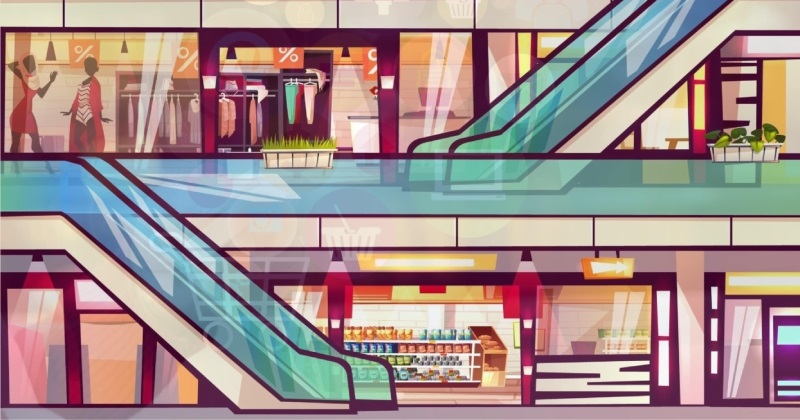Combining technology with Brick and Mortar stores in the GCC: 6 ideas

Euromonitor International projects that the retail sales across Kuwait, Oman, Saudi Arabia and UAE will increase by more than USD 24 billion over the next five years. The UAE retail industry currently (worth USD 55 billion) will lead the trend reaching to USD 63.8 billion by 2023, at an estimated growth rate of 16%. Non-store modes of retailing such as online shopping, direct selling, social media and home shopping is estimated to grow by 78 percent from 2018 to 2023.
However, global picture is slightly different. In 2017, closing of about 7000 retail shops were announced and bankruptcy in the sector increased by 30% as compared to 2016. Customer expectations for brick and mortar store experiences are changing rapidly. Forrester estimates that 53% of all purchase decisions are digitally influenced. With the widespread growth of e-commerce websites and applications, the shoppers expect customers services like detailed product information in store, read ratings and reviews and access the best available price.
Sales at supermarket and hypermarket outlets in the GCC region are estimated to reach USD 70.1 billion by 2021, growing at a CAGR of 4.3%. This indicates that there will be an increase in the establishment of regional as well as international players, especially in Kuwait, Qatar and Saudi Arabia.
Retail space in GCC is continuously expanding and diversifying in response to the changing demographic patterns and increasing tourism activity. Shopping malls are developed with the intent of providing customers with the experience of shopping, dining and entertainment. Multipurpose malls in the region like Dubai Mall, Mall of Emirates, Kuwait Marina Mall etc. have transformed shopping into a lifestyle.
Customers have high expectations of what the store looks like and how their shopping experience should be.
Below are some technology that brick and mortar stores in the GCC can adopt for a better and efficient retail shopping experience:
1. Connected Inventory Management
Internet of Things (IoT), blockchain and RFID sensors can replace manual shelf monitoring and restocking, thus eliminating the issue of ‘out of stock’ which is persistent in retail outlets. Inventory robots are used by retailers like Amazon to automate to check the stock and automate re-ordering.
2. Personalized Recommendations
E-commerce sites offer the feature of providing recommendations of products that are similar or complementary to the one selected. However, in the brick and mortar stores, the customer relies on the sales person or personal observation to get similar products or see the available options.
In a brick and mortar store, this can be made possible through interactive displays than recognize the selected product, provide options and display alternatives or products that complements it. Supermarkets in Europe uses motion sensors that displays the product information.
The Apple Store in the Mall of the Emirates provides customers an immersive and engaging shopping experience whereby they gain a complete understanding of the technology that is offered instead of feeling pressured to purchase the product.
3. Smart Trial Rooms
In case of textile stores, the crowd especially at trial rooms can be de-motivating to continue with the shopping. Smart trial rooms are interactive in nature and assist customers throughout product selection by providing recommendations, apart from helping them trying on clothes without going back to the shopping floor.
The Marks and Spencer’s stores in Middle East have launched the virtual Closet, which uses augmented reality for customers to try the outfits and accessories before purchase.
4. Self-Checkout Options
Customers at physical retails often face the challenge of long queues at the billing counter as opposed to easy checkout and payment, discounted fares through coupon application in e-commerce sites. This can be tackled by providing self-checkout solutions at the store which gives the customer the power to be in charge of the entire shopping process.
Mikropis based in South Korea is aiming to install self-checkouts in retail outlets by collaborating with IBM and Toshiba. Although it is currently present across South Korea and China, it is planning expansion into other Asian and Middle Eastern regions.
5. Store Optimization
IoT based technology can provide the executives and employees with data and analytics of the store which would provide insights into customer behavior, product movement and purchase trends that can be used to improve store efficiency and shopping experience.
6. Micro Trips
Brick and Mortar stores especially grocery stores are encouraging their customers to undertake micro trips, in which they can order online and pick up in person with the entire time spent at the store being less than five minutes.
In order to adapt to the evolving retail space and customer requirements, players in the retail sector should develop an omnichannel approach where they establish a strong online presence, robust and multiple payment mechanisms, and an efficient distribution and logistics network. Customer experience is the priority for any service provider, and same is the case with brick and mortar stores. They should be able to offer the ease and convenience that online retailers successfully provide within the physical infrastructure of the retail store.
